Olympus E-3
-
-
Written by Gordon Laing
Olympus E-3 lens and stabilisation
 |
The Olympus E-3 employs a Four Thirds lens mount and is compatible with the complete range of Four Thirds lenses which includes models from Olympus, Sigma and Panasonic / Leica. All these lenses are designed from the ground-up for DSLR use and many offer compelling facilities or features – to find out more about one of our favourite models, check out our Olympus Zuiko Digital 7-14mm review.
Like other Four Thirds DSLRs, the E-3’s sensor size effectively reduces the lens field of view by two times, so the popularly-matched Zuiko Digital 12-60mm SWD delivers a 35mm equivalent focal length of 24-120mm. This is an ideal general-purpose lens for the E-3 with some stores even selling it as a kit, so compare prices for possible savings if you’re interested in both products; look out for a full review of it in the future. The range of this lens in practice is illustrated below.
|
Olympus E-3 with Zuiko Digital 12-60mm SWD coverage | ||
 | ||
12-60mm at 12mm (24mm equivalent) |
12-60mm at 60mm (120mm equivalent) | |
The Olympus E-3 follows the E-510 to become the second Four Thirds DSLR to feature built-in Image Stabilisation, or IS for short. Like the Sony Alpha and suitably-equipped Pentax DSLRs, this physically shifts the sensor to compensate for any wobbles it detects.
The major benefit of built-in sensor-shift stabilisation is that it works with any lens you attach. The big downside is not seeing the reassuring effect of stabilisation through the optical viewfinder, but you can preview the effect during Live View by pressing and holding the IS button. Of course holding the E-3 out in front of you to see the screen in Live View can introduce wobbles of its own, but the preview’s there if you want it, and we have a demonstration in our video tour.
 |
The E-3’s Image Stabilisation employs a Supersonic Wave Drive (SWD) motor to adjust the sensor’s position in the x and y axes, and pressing the dedicated IS button on the rear offers three modes: Off for use on tripods or to save power, IS 1 which applies compensation in both axes, and IS 2 which only applies compensation in the vertical axis for when you’re panning horizontally. Olympus claims up to 5 stops of compensation are possible which is greater than the 3 or 4 stops of rival systems. The firmware 1.1 update released in late January 2008 also allows you to use the IS system with non-Four Thirds lenses by manually entering their focal length.
To test the effectiveness of the E-3’s built-in stabilisation we fitted the Zuiko Digital 12-60mm SWD lens and took a serious of photos with it zoomed-into an equivalent of 120mm where traditional photographic advice would recommend a shutter speed of approximately 1/120 to eliminate camera shake. Our sequence therefore started at 1/125 and reduced by one stop each time until 1/4.
Olympus E-3 with Zuiko Digital 12-60mm SWD Image Stabilisation off / on | ||
 | 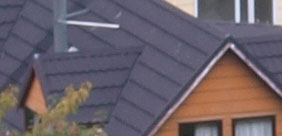 | |
100% crop, 12-60mm at 60mm, 1/8, 100 ISO, IS off |
100% crop, 12-60mm at 60mm, 1/8, 100 ISO, IS on | |
Without the built-in stabilisation enabled, the slowest shutter speed with which we could achieve a sharp image (at an equivalent of 120mm) was 1/125, whereas with IS enabled we achieved sharp results down to shutter speeds of 1/8, and those at 1 /4 weren’t bad. You can see 100% crops taken from the 1/8 samples above, with and without IS enabled.
A shutter of 1/8 corresponds to four stops of compensation over the 1/125 non-stabilised shot, while 1 /4 corresponds to five stops. As always, the lens, conditions and the photographer themselves can produce different results. Achieving four to five stops of compensation in real-life though is a very impressive result for the E-3.
Note that like the E-510 before it, the E-3 vibrates as it powers down. This is its Image Stabilisation system performing diagnostics and resetting itself. It’s perfectly normal operation on both cameras, but if it bothers you, just switch off the IS before powering the camera down.
Olympus E-3 focusing
Alongside a small viewfinder, auto-focusing was never a strong point for Four Thirds DSLRs. All models to date featured a basic 3-point system which just wouldn’t cut the mustard on a new flagship like the E-3. After all the Canon 40D, Sony A700 and Nikon D300 have 9, 11 and 51 point AF systems respectively.
 |
 |
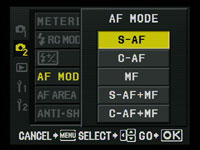 |
So with the E-3, Olympus has pulled out all the stops and not just equipped it with a brand new 11-point AF system, but one which Olympus claims is the World’s fastest – so no pressure there then. The 11 points are all cross-type and arranged over a wide area across three horizontal rows, with three at the top, five in the middle and three at the bottom. Each point is indicated by a square in the optical viewfinder which illuminates red when active.
Three AF area modes allow you to either use all 11 points, just one of your choice, or a group of five in a plus-sign which can be nudged up down, left or right. In terms of AF modes, you can choose Single, Continuous, Single with Manual focus, Continuous with Manual focus or just plain Manual focus. You can also adjust the AF sensitivity, set the release priority to fire or not when the AF is operating or the flash charging, and choose whether the lenses reset their focus to infinity when powered-down or not.
 |
 |
Speaking of manual focus, the E-3 allows you to change the direction of the focusing ring. This applies to existing Four Thirds lenses with motor-assisted focusing rings, and lets you choose whether a clockwise or anti-clockwise turn focuses from close to far. This can be quite spooky for lenses which also have focus distance markings in a window as you can turn the focus ring one way and see the markings turn the other. Thankfully that’s not the case with the classy Zuiko Digital 12-60mm SWD, which has a traditional mechanically-linked focusing ring that’s not influenced by this setting.
So back to that claim of the World’s fastest AF, which according to Olympus was a result of its own survey and only applies when fitted with the Zuiko Digital 12-60mm SWD lens. We fitted this lens to the E-3, and certainly under the right conditions, the AF could be extremely quick. It would literally snap into sharp focus almost instantly, and subjectively felt quicker than many of Canon’s USM and Nikon’s SWM lenses when mounted on their respective semi-pro bodies.
So far so good, but again subjectively, it didn’t feel as consistent as rival AF systems. When the E-3’s AF system was happy, it could be astoundingly quick, but at other times, it would search a little while rival systems tested alongside had no problems. For example we found it less consistent when it came to tracking moving subjects than Canon and Nikon’s semi-pro models. In our test of tracking vehicles approaching face on at around 50kph, the E-3 only reliably locked-onto about half of them, when the EOS 40D and D300 enjoyed a much higher success rate.
So the AF system is a bit of a mixed bag and perhaps Olympus shouldn’t have got our hopes up by describing it as the World’s fastest. It’s certainly a huge improvement over previous Four Thirds capabilities and extremely quick at times, but not consistently quick or reliable enough for us to recommend it over, say, the EOS 40D or D300 for serious sports photography.
This is of course our subjective opinion and your results may vary. The E-3 certainly has a wide array of AF settings and further tweaking could find it performing better under specific conditions as you learn how to make the most from it. Our point here is rival semi-pro DSLRs offered more reliable and consistent AF performance in our tests using their default settings.
Olympus E-3 metering
The Olympus E-3 offers five metering modes: 49-zone Digital ESP, Center weighted and three types of spot metering. Alongside a ‘normal’ spot metering mode are those with Highlight or Shadow control for situations when the overall background is bright or dark respectively. The spot metering area is the same on all three modes though and indicated on the focusing screen in the viewfinder.
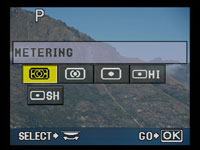 |
To adjust the metering mode, you’ll need to peer to the left side of the prism head to see label indicating the dual-purpose of the AF button. Hold this while turning the finger dial to change the mode.
We used the default Digital ESP metering mode for all our test shots and found it delivered well-balanced results in most situations. Like many cameras, our darker indoor test scenes occasionally required some positive exposure compensation, but on the whole, the metering was pretty reliable.
Olympus E-3 anti dust
In a DSLR market where anti-dust facilities are becoming the norm, it’s important to remember Olympus was the first to truly address the problem. So the E-3 follows a line of Four Thirds DSLRs equipped with the SuperSonic Wave Filter (SSWF). This vibrates a filter in front of the sensor in an attempt to shake-free any foreign particles and has proven more effective than rivals.
 |
Dust reduction takes place every time the camera powers-up and when entering and exiting Live View or activating the pixel mapping function – the process is indicated by a brief flicker of the SSWF light to the lower right of the colour monitor.
Following our usual DSLR torture-test we left the E-3 face-up without a lens, inside and outside for ten minutes each; we can’t know how much dust entered the body during this time, nor even how much was present to start with, but we know such a process would result in dust being a problem for most models.
We then activated the SSWF by powering the camera on and off twice, before taking a series of photos at every aperture setting of a plain white surface at close range with the Zuiko Digital 12-60mm SWD lens zoomed-into 60mm and manually focused to infinity. Dust marks normally become most apparent at the smallest apertures (eg f16 and f22), but it’s also important to test at more common apertures.
Olympus E-3 dust example at f22 / f11 | ||
 |  | |
100% crop, 12-60mm at 60mm, f22 |
100% crop, 12-60mm at 60mm, f11 | |
At f22 we spotted one diffuse dust mark, and have pictured a 100% crop of it above left. At f16 it was getting fainter and by f11 it was essentially invisible; we’ve pictured the same area from the f11 image above right, and if you apply auto levels to it, you’ll see it’s grown to a very diffuse circle which almost touches the top and bottom of the frame.
So this time round the legendary SSWF wasn’t quite as infallible as previous Four Thirds models, but at least we didn’t have to open the aperture to f8 or wider until it was effectively rendered invisible. The random nature of dust testing means it’s important to also consider samples from similar systems. So since the SSWF has performed so well on previous tests with other DSLRs, we’re willing to give it at least some benefit of the doubt here, although our result does again prove that no anti-dust system is 100% infallible.
Olympus E-3 sensor and processing
The Olympus E-3 is equipped with a 10.1 Megapixel Live MOS sensor which conforms to the Four Thirds standard and therefore measures 17.3x13mm. It generates 4:3 aspect ratio images which are narrower than the traditional 3:2 aspect ratio of other DSLRs. This is not the same sensor used by the E-410 and E-510, although the maximum resolution is the same 3648×2736 pixels and there’s the choice of no fewer than six lower resolutions.
 |
 |
Following earlier Olympus DSLRs, there’s also a wealth of JPEG compression options including the very mild SuperFine mode alongside Fine, Normal and Basic. Alternatively you can record a 12-bit RAW file either by itself or accompanied by a JPEG in the Large Fine, Large Normal, Medium Normal or Small Normal sizes – so there’s plenty of choice and you can even configure the camera to delete either the RAW file, the JPEG file or both when you hit the trash button.
Large Fine JPEGs typically measure 4.5MB each, while RAW files weigh in between 9 and 11MB each. The least-compressed Superfine JPEG mode generates files measuring around 7MB each, and while they’re virtually bereft of any compression artefacts, you may prefer to go for the flexibility of RAW files which are typically only 50% bigger. To see resolution and detail results from the E-3 compared to the Nikon D300 and other DSLRs, check out our results pages.
 |
 |
Sensitivity runs between 100 and 3200 ISO in increments of one third. The E-3 offers noise reduction and like the E-510, there’s also four different noise filter settings, Off, Low, Standard and High, which apply to sensitivities of 800 ISO and above – we have examples at all the settings in our results pages, where we found reducing the noise filter from the default could deliver preferable results.
Alongside Auto White Balance and eight presets, there’s four custom presets and the option to dial in an exact colour temperature. You can also fine-tune the white balance in the amber / blue or green / magenta directions, or apply adjustments as part of a three-frame white balance bracketing option. White balance adjustments can also be previewed in Live View.
 |
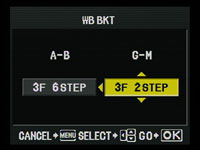 |
 |
Like the E-510 and E-410 before it, contrast, sharpness and saturation are applied using a choice of Picture Modes, although alongside Vivid, Natural, Muted and Monotone is a new Portrait option. In the colour Picture Modes, contrast, sharpness and saturation can all be adjusted on a scale of -2 to +2. In the Monotone mode you can apply colour effects including a sepia tone, or simulate the use of colour filters including yellow, orange, red and green.
 |
 |
 |
We used the default Natural setting which is more refrained than the Vivid mode and better-suited to subsequent enhancement in software. If you intend to use JPEGs straight from the camera though, the Vivid mode delivers punchier output without going over the top.
Also following the E-410 and E-510, the E-3 additionally offers a choice of Graduation options: along with the default Normal there’s High Key and Low Key settings which extend tonal graduations for subjects which are mostly highlighted or in shadow respectively. Finally, a feature inherited from the E-500 and E-510 is Shading Compensation, which digitally counteracts darkening in the corners of the frame caused by lens vignetting.
Olympus E-3 drive modes
The Olympus E-3 offers two continuous shooting modes: Continuous H shoots at 5fps, while Continuous L shoots at one to four fps, depending on the setting of a custom function. Since the E-3 is compatible with high speed UDMA compact flash cards, we fitted a Lexar Professional UDMA 300x 4GB card and put the specifications to the test.
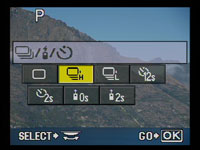 |
 |
Set to Continuous High, we shot 28 Large Fine JPEGs in 5.5 seconds before the camera slowed slightly; this corresponds to a rate of almost exactly 5fps and the buffer was flushed just three seconds after we repeated the test and let go at the 28 frame mark.
Set to RAW mode, the E-3 captured 20 shots in 4.3 seconds before slowing, corresponding to a rate of 4.7fps; this time the buffer emptied in six seconds after we repeated the test and let go at the 20-frame mark.
This makes the E-3 comfortably quicker than the 3fps of previous Olympus DSLRs, and quick enough for capturing faster action sequences. It also makes it roughly equivalent in speed to the Sony Alpha DSLR A700, although a tad slower than the Canon EOS 40D and Nikon D300 both of which we measured at around 6fps in practice.
In terms of other drive modes, there’s the choice of a two or 12 second self-timer, and two options for use with the optional IR remote control, one which fires as you press the button and the other which fires after a two second delay. Impressively you can also adjust the delay of a mirror-lockup between one to 30 seconds.
 |
 |
Along with flash and white balance bracketing mentioned earlier, there is of course exposure bracketing available on the E-3. You can choose between three or five frames in steps of 1/3, 2/3 or 1EV. Five frames are nice, but for serious HDR work it would have been good to have bigger EV steps between them. There also aren’t any built-in Intervalometer features like the D300, although it is possible to remote control the camera with the optional Studio software – albeit not with a live preview like the free software supplied with the Canon EOS 40D and even the EOS 450D / XSi.




